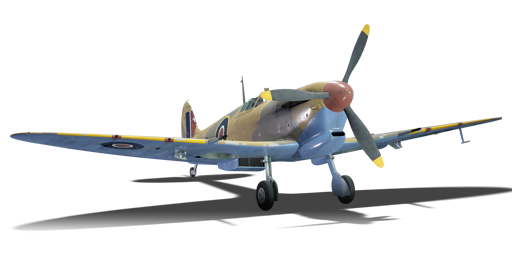



In order to adapt the Spitfire Mk Vb for overseas operations, such as in Malta, North Africa, Burma, and Australia, the aircraft was equipped with a large air filter under the nose, as well as other modifications such as a larger oil coolant tank and desert survival gear behind the pilot's seat. The restricted airflow to the supercharger reduced the performance of the engine, but this was deemed acceptable. A desert camouflage was also applied to match its new arenas of service.
In the game since the start of the Open Beta Test, the Spitfire Mk Vb/trop sports a new and more powerful Merlin 45 inline engine compared to the previous Merlin XII engine, giving it an extra 100 horsepower when upgraded, which provides better high altitude performance and faster top speed than the Mk IIb. Unfortunately, the Mk Vb/trop still has similar problems to the early Spitfires such as a very weak airframe, weak wings, bad roll rate at high speeds and lack of combat flaps to help with dog-fighting. The Spitfire fights best at close-range. The basic strategy that many Spitfire pilots use is a tactic whereby they bait head-ons from enemy aircraft, before evading and turning around to put shots into the target at close range while the enemy is pulling out. When the Spitfire has the initiative in the engagement and has successfully manoeuvred onto a six-o-clock aspect, it is nearly impossible for the opponent to regain the advantage. Using clever management of the throttle and manoeuvres to gain or bleed energy, an experienced pilot can maintain the initiative in the engagement and stay on an opponent's six o'clock.
flaps
flaps
flaps
brake
| Belt | Belt filling | Armor penetration (mm) at a distance: | |||||
|---|---|---|---|---|---|---|---|
| 10 m | 100 m | 500 m | 1000 m | 1500 m | 2000 m | ||
| HEI/SAP-I/T | 22 | 20 | 14 | 9 | 6 | 4 | |
| AP-T/HEI/SAP-I | 37 | 35 | 25 | 16 | 10 | 7 | |
| T/HEI/SAP-I/HEI/SAP-I | 22 | 20 | 14 | 9 | 6 | 4 | |
| AP-T/T/HEI | 37 | 35 | 25 | 16 | 10 | 7 | |
| AP-T/SAP-I/HEI/AP-T | 37 | 35 | 25 | 16 | 10 | 7 | |
| HEI/HEI/SAP-I | 22 | 20 | 14 | 9 | 6 | 4 | |
| Belt | Belt filling | Armor penetration (mm) at a distance: | |||||
|---|---|---|---|---|---|---|---|
| 10 m | 100 m | 500 m | 1000 m | 1500 m | 2000 m | ||
| T/AP/AP-I/Ball/Ball/I | 13 | 12 | 7 | 3 | 2 | 0 | |
| T/AP/AP-I/AP-I/I | 13 | 12 | 7 | 3 | 2 | 0 | |
| IT/AP-I | 13 | 12 | 7 | 3 | 2 | 0 | |
| AP-I/AP-I/I | 13 | 12 | 7 | 3 | 2 | 0 | |












Flight performance | |
|---|---|
Survivability |
|---|
Weaponry | |
|---|---|